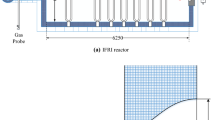Abstract
Fluent reaction flow has been widely used in the simulation of uniform or non-uniform reaction flow including boilers, gas turbines and rocket engines. Flow field characteristics, material concentration and pollutant generation can be obtained (Travin et al. in Advances in LES of complex flows, vol 65, pp 239–254, 2002). In order to study the combustion stability of coal slurry in the double cone burner, numerical investigation based on Reynolds-Averaged Navier Stokes (RANS) equations (Chen and Ghoniem in Energy Fuels 26:4783–4798, 2012) was explored in this paper. Besides, a reverse jet device for atomization is set up in the pulverized coal double cone reverse jet burner. and a test platform to verify the numerical simulation results is obtained. The simulated data are verified by the experimental data. The results show that a numerical simulation platform for coal slurry combustion process has been established. Based on the test and calculation results obtained, the pulverized coal double cone burner is optimized for the coal slurry combustion. The technical measures include that the diameter of the burner outlet is reduced from 500 to 450 mm, the angle of the front cone is increased from 7° to 9°, the swirling flow strength is increased by 20%, and the preheating temperature of the combustion air is increased from 20 to 150 °C. The simulation results show that after optimization, the temperature in the burner increases by 120 °C, the combustion process is effectively strengthened, and the front cone pressure is reduced. the temperature in the burner can be increased, and the combustion of coal slurry can be more efficient. Therefore, the adoption of technical means can effectively solve the problem of coal slurry combustion organization.
Access this chapter
Tax calculation will be finalised at checkout
Purchases are for personal use only
Similar content being viewed by others
References
Arenillas A, Rubiera F, Pevida C et al (2001) A comparison of different methods for predicting coal devolatilisation kinetics. J Anal Appl Pyrol 58(2):685–701
Chen L, Ghoniem AF (2012) Simulation of oxy-coal combustion in a 100 kWth test facility using RANS and LES: a validation study. Energy Fuels 26(8):4783–4798
Cheng J, Zhou J, Li Y et al (2008) Improvement of coal water slurry property through coal physicochemical modifications by microwave irradiation and thermal heat. Energy Fuels 22(4):2422–2428
Crespo A, Li AA (1975) Unsteady effects in droplet evaporation and combustion. Combust Sci Technol 11(1–2):9–18
Fuertes AB, Marbán G, Pis J (1994) Combustion kinetics of coke particles in a fluidized bed reactor. Fuel Process Technol 38(3):193–210
Gadiou R, Bouzidi Y, Prado G (2002) The devolatilisation of millimetre sized coal particles at high heating rate: The influence of pressure on the structure and reactivity of the char. Fuel 81(16):2121–2130
Ghose P, Patra J, Datta A et al (2014) Effect of air flow distribution on soot formation and radiative heat transfer in a model liquid fuel spray combustor firing kerosene. Int J Heat Mass Transf 74(5):143–155
Heynderickx GJ, Schools EM, Marin GB (2005) Coke combustion and gasification kinetics in ethane steam crackers. AIChE J 51(5):1415–1428
Jones JM, Kubacki M, Kubica K et al (2005) Devolatilisation characteristics of coal and biomass blends. J Anal Appl Pyrol 74(1–2):502–511
Liu J, Chen S, Liu Z et al (2012) Mathematical modeling of air– and oxy-coal confined swirling flames on two extended eddy-dissipation models. Ind Eng Chem Res 51(2):691–703
Menon S, Genin F, Chernyavsky B (2003) Large eddy simulation of scramjet combustion using a subgrid mixing/combustion model. In: 12th AIAA international space planes and hypersonic systems and technologies
Mishra SK, Senapati PK, Panda D (2002) Rheological behavior of coal-water slurry. Energy Sources 24(2):159–167
Raman V, Pitsch H, Fox RO (2006) Eulerian transported probability density function sub-filter model for large-eddy simulations of turbulent combustion. Combust Theor Model 10(3):439–458
Subramaniam S (2013) Lagrangian-Eulerian methods for multiphase flows. Prog Energy Combust Sci 39(2–3):215–245
Tamarin AI, Galershtein DM, Shuklina VM (1982) Heat transfer and the combustion temperature of coke particles in a fluidized bed. J Eng Phys 42(1):14–19
Tamura Z, Tanasawa Y (1958) Evaporation and combustion of a drop contacting with a hot surface. Symp Combust 7(1):509–522
Travin A, Shur M, Strelets M et al (2002) Physical and numerical upgrades in the detached-eddy simulation of complex turbulent flows. Advances in LES of complex flows, vol 65, pp 239–254
Yavuzkurt S, Ha MY (1991) A model of the enhancement of combustion of coal-water slurry fuels using high-intensity acoustic fields. J Energy Res Technol 113(4):268
Zhang X, Sui Z, Zhou X et al (2010) Modeling and simulation of coke combustion regeneration for coked Cr2O3/Al2O3 propane dehydrogenation catalyst. Chin J Chem Eng 18(4):618–625
Acknowledgements
This work was supported by the Coal Science and Technology Development Fund (NO. 2018CX02).
Author information
Authors and Affiliations
Corresponding author
Editor information
Editors and Affiliations
Rights and permissions
Copyright information
© 2022 Tsinghua University Press.
About this paper
Cite this paper
RiGen, M., Shi, Y., JianHang, L. (2022). Numerical Investigation on Combustion Stability of Coal Slurry in the Double Cone Burner. In: Lyu, J., Li, S. (eds) Clean Coal and Sustainable Energy. ISCC 2019. Environmental Science and Engineering. Springer, Singapore. https://doi.org/10.1007/978-981-16-1657-0_33
Download citation
DOI: https://doi.org/10.1007/978-981-16-1657-0_33
Published:
Publisher Name: Springer, Singapore
Print ISBN: 978-981-16-1656-3
Online ISBN: 978-981-16-1657-0
eBook Packages: EnergyEnergy (R0)




